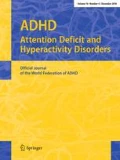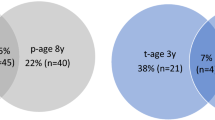Abstract
The aim of this study was to explore the prevalence of attention deficit hyperactivity disorder (ADHD) and social and academic impairment in 6- to 11-year-old children residents of Athens, Greece. We screened 603 elementary schoolchildren following grades first to sixth. A two-stage screening process was employed including a standardized ADHD test for teachers and the Teacher Report Form (TRF). Among the 603 children, 36 (6.0%) met the study criteria for ADHD. The estimated prevalence was 8% for boys and 3.8% for girls. The most prevalent subtype of ADHD was the combined type (3.8%), followed by the ADHD inattentive (1.7%) and the ADHD hyperactive-impulsive type (0.5%). The ADHD-combined type was strongly associated with clinical impairment in both areas of functioning (academic and social), where the ADHD inattentive subtype was found to be strongly associated with academic problems. The ADHD hyperactive-impulsive type was the less prevalent and the less impaired subtype in this study. None of the 36 children had been previously diagnosed as having ADHD or other primary disorder. In conclusion, the prevalence of ADHD among schoolchildren in Athens and the risk factors were found to be comparable to those reported in other countries worldwide. Additionally, impairment in social and academic functioning was strongly associated with the subtypes of the disorder.
Similar content being viewed by others
References
Achenbach TM, Rescorla LA (2003) Manual for school age questionnaires and profiles of Achenbachs’ empirical system evaluation. Ellinika Grammata, Athens (in Greek)
Adewuya AO, Famuyiwa OO (2007) Attention deficit hyperactivity disorder among Nigerian primary school children: prevalence and co-morbid conditions. Eur Child Adolesc Psychiatry 16:10–15
Alobaidi AK, Ali NS (2009) Attention deficit/hyperactivity disorder among schoolchildren in Baghdad. J Can Acad Child Adolesc Psychiatry 18:4–5
American Academy of Pediatrics (2000) Clinical practice guideline: diagnosis and evaluation of the child with attention-deficit/hyperactivity disorder. Pediatrics 105:1158–1170
Association American Psychiatric (1994) The diagnostic and statistical manual of psychiatric disorders, 4th edn. American Psychiatric Association, Washington DC
Anastopoulos AD, Shelton TL (2001) Assessing attention deficit/hyperactivity disorder. Kluwer Academic/Plenum Press, New York
Baumgaertel A, Wolraich ML, Dietrich M (1995) Comparison of diagnostic criteria for attention deficit disorders in a German elementary school sample. J Am Acad Child Adolesc psychiatry 34:629–638
Bayens D, Roeyers D, Vande Walle J (2006) Subtypes of attention deficit/hyperactive disorder (ADHD): distinct or related disorders across measurement levels. Child Psychiatry Hum Dev 36:403–417
Bener A, Qahtani RA, Abdelaal I (2006) The prevalence of ADHD among primary school children in an Arabian society. J Atten Disord 10:77–82
Benjasuwantep B, Ruangdaraganon N, Visudhiphan P (2002) Prevalence and clinical characteristics of attention deficit hyperactivity disorder among primary school students in Bangkok. J Med Assoc Thai 85(Suppl 4):S1232–S1240
Canino G, Shrout PE, Rubio-Stipec M, Bird HR, Bravo M, Ramirez R, Chavez L, Alegria M, Bauermeister JJ, Hohmann A, Ribera J, Garcia P, Martinez-Taboas A (2004) The DSM-IV rates of child and adolescent disorders in Puerto Rico: prevalence, correlates, service use, and the effects of impairment. Arch Gen Psychiatry 61:85–93
Carlson CC, Mann M (2000) Attention deficit hyperactivity disorder, predominantly inattentive subtype. Child Adolesc Psychiatr Clin N Am 9:499–506
Carlson CL, Shin M, Booth J (1999) The case for DSM-IV subtypes in ADHD. MRDD Research Reviews 5:199–206
Costello EJ, Mustillo S, Erkanli A, Keeler G, Angold A (2003) Prevalence and development of psychiatric disorders in childhood and adolescence. Arch Gen Psychiatry 60:837–844
Cuffe SP, Moore CG, McKeown RE (2005) Prevalence and correlates of ADHD symptoms in the national health interview survey. J Atten Disord 9:392–401
Döpfner M, Breuer D, Wille N, Erhart M, Ravens-Sieberer U, BELLA study group (2008) How often do children meet ICD-10/DSM-IV criteria of attention deficit/hyperactivity disorder and hyperkinetic disorder? Parent-based prevalence rates in a national sample–results of the BELLA study. Eur Child Adolesc Psychiatry 174(Suppl 1):59–70
Ersan EE, Dogan O, Dogan S, Somer H (2004) The distribution of symptoms of attention-deficit/hyperactivity disorder and oppositional defiant disorder in school age children in Turkey. Eur Child Adolesc Psychiatry 13:354–361
Gathje RA, Lewandowski LJ, Gordon M (2008) The role of impairment in the diagnosis of ADHD. J Atten Disord 11(5):529–537
Gaub M, Carlson C (1997) Behavioral characteristics of DSM-IV ADHD subtypes in a school-based population. J Abnorm Child Psychol 25:103–111
Gomez R, Harvey J, Quick C, Scharer I, Harris G (1999) DSM-IV AD/HD: confirmatory factor models, prevalence, and gender and age differences based on parent and teacher ratings of Australian primary school children. J Child Psychol Psychiatry 40:265–274
Gordon M, Antshel K, Faraone S, Barkley R, Lewandowski L, Hudziak JJ, Biederman J, Cunningham C (2006) Symptoms versus impairment: the case for respecting DSM-IV’s Criterion D. J Atten Disord 9:465–475
Görtz-Dorten A, Döpfner M (2009) Attention deficit/hyperactive disorders in children and adolescents as assessed by parents. Z Kinder Jugendpsychiatr Psychother 37:183–194 (Article in German)
Graetz BW, Sawyer MG, Hazell PL, Arney F, Baghurst P (2001) Validity of DSM-IV ADHD subtypes in a nationally representative sample of Australian children and adolescents. J Am Acad Child Adolesc Psychiatry 40:1410–1417
Healey DM, Miller CJ, Castelli KL, Marks DJ, Halperin JM (2008) The impact of impairment criteria on rates of ADHD diagnoses in preschoolers. J Abnorm Child Psychol 36(5):771–778
Hudziak JJ, Heath AC, Madden PF, Reich W, Bucholz KK, Slutske W, Bierut LJ, Neuman RJ, Todd RD (1998) Latent class and factor analysis of DSM-IV ADHD: a twin study of female adolescents. J Am Acad Child Adolesc Psychiatry 37:848–857
Kalantzi-Azizi A, Aggeli K, Efstathiou G (2005) The Greek version of ADHD rating scale -IV of DuPaul GJ, Power TJ, Anastopoulos AD, Reid R. Ellinika Grammata, Athens (In Greek)
Magnusson P, Smari J, Gretarsdottir H, Prandardottir H (1999) Attention-deficit/hyperactivity symptoms in Icelandic schoolchildren: assessment with the attention Deficit/hyperactivity rating scale-IV. Scand J Psychol 40:301–306
Montiel-Nava C, Pena JA, Lopez M, Salas M, Zurga JR, Montiel-Barbero I, Pirela D, Cardozo JJ (2002) Estimations of the prevalence of attention deficit hyperactivity disorder in Marabino children. Rev Neurol 35:1019–1024 (In Spanish)
Mugnaini D, Masi G, Brovedani P, Chelazzi C, Marzenka M, Romagnoli C, Zuddas A (2006) Teacher reports of ADHD symptoms in Italian children at the end of first grade. European Psychiatry 21:419–426
Nolan EE, Gadow KD, Sprafkin J (2001) Teacher reports of DSM-IV ADHD, ODD, and CD symptoms in schoolchildren. J Am Acad Child Adolesc Psychiatry 40:241–249
Pineda DA, Lopera F, Palacio JD, Ramirez D, Henao GC (2003) Prevalence estimations of attention-deficit/hyperactivity disorder: differential diagnoses and comorbidities in a Colombian sample. Int J Neurosci 113:49–71
Polanczyk G, de Lima MS, Horta BL, Biederman J, Rohde LA (2007) The worldwide prevalence of ADHD: A systematic review and metaregression analysis. Am J Psychiatry 164:942–948
Romano E, Tremblay RE, Vitaro F, Zoccolillo M, Pagani L (2001) Prevalence of psychiatric diagnoses and the role of perceived impairment findings from an adolescent community sample. J Child Psychol Psychiatry 42:451–461
Rowland AS, Umbach DM, Catoe KE, Stallone L, Long S, Rabiner D, Naftel AJ, Panke D, Faulk R, Sandler DP (2001) Studying the epidemiology of attention-deficit hyperactivity disorder: screening method and pilot results. Can J Psychiatry 46:931–940
Scahill L, Schwab-Stone M (2000) Epidemiology of ADHD in school-age children. Child Adolesc Psychiatr Clin N Am 9:541–555
Shaffer D, Fisher P, Dulcan MK, Davies M, Piacentini J, Schwab-Stone ME, Lahey BB, Bourdon K, Jensen PS, Bird HR, Canino G, Regier DA (1996) The NIMH Diagnostic Interview Schedule for Children Version 2.3 (DISC-2.3): description, acceptability, prevalence rates, and performance in the MECA Study. Methods for the Epidemiology of Child and Adolescent Mental Disorders Study. J Am Acad Child Adolesc Psychiatry 35:865–877
Skounti M, Philalithis A, Mpitzaraki K, Vamvoukas M, Galanakis E (2006) Attention deficit hyperactivity disorder in schoolchildren in Crete. Acta Paed 95:658–663
Skounti M, Philalithis A, Galanakis E (2007) Variations in prevalence of attention deficit hyperactivity disorder worldwide. Eur J Pediatr 166:117–123
Skounti M, Mpitzaraki K, Philalithis A, Galanakis E (2009) Clinical evaluation of children testing positive in screening tests for attention deficit/hyperactivity disorder: A preliminary report. Eur J Psych 23:115–120
Wolraich ML, Hannah JN, Pinnock TY, Baumgaertel A, Brown J (1996) Comparison of diagnostic criteria for attention-deficit hyperactivity disorder in a county-wide sample. J Am Acad Child Adolesc Psychiatry 35:319–324
Wolraich ML, Hannah JN, Baumgaertel A, Feurer ID (1998) Examination of DSM-IV criteria for attention deficit/hyperactivity disorder in a county-wide sample. J Dev Behav Pediatr 19:162–168
Acknowledgments
We wish to acknowledge our gratitude to all teachers of classes, without whose contribution this study would not have been accomplished.
Author information
Authors and Affiliations
Corresponding author
Rights and permissions
About this article
Cite this article
Skounti, M., Giannoukas, S., Dimitriou, E. et al. Prevalence of attention deficit hyperactivity disorder in schoolchildren in Athens, Greece. Association of ADHD subtypes with social and academic impairment. ADHD Atten Def Hyp Disord 2, 127–132 (2010). https://doi.org/10.1007/s12402-010-0029-8
Received:
Accepted:
Published:
Issue Date:
DOI: https://doi.org/10.1007/s12402-010-0029-8



